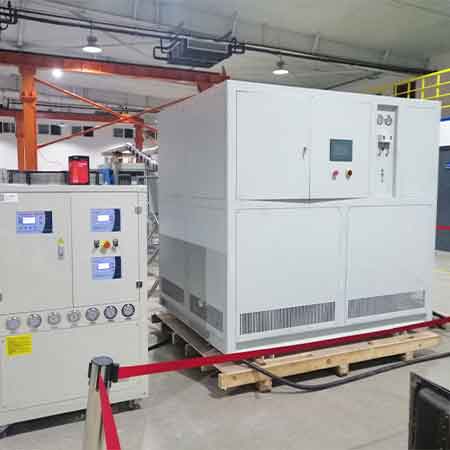Chiller Products
Kontaktieren Sie uns noch heute für die perfekte Lösung zur Temperaturkontrolle
Chiller component structure and composition
There are four main components that constitute the basic refrigeration system of a chiller: compressor, evaporator, condenser, and throttle valve. In addition, there are many auxiliary devices: liquid pipeline solenoid valves, sight glasses, liquid pipeline drying filters, high and low pressure controllers, etc.
Working principle of chiller:
The chiller compresses the refrigerant into a liquid state through the compressor and sends it to the evaporator for heat exchange with the chilled water to cool the chilled water. The freezing pump sends the chilled water to the cooling coil at each fan outlet, and is blown by the fan to achieve cooling. Purpose. The evaporated refrigerant releases heat in the condenser and turns into a gaseous state. The cooling pump sends the cooling water to the cooling tower. The water tower fan sprays and cools it. It exchanges heat with the atmosphere and dissipates the heat into the atmosphere.

1. Chiller
This is the “heart” of the refrigeration system. The circulating water leading to each room is “internally exchanged” by the chiller and cooled down into “cooling water”.
2. External heat exchange system
Two circulating water systems: The chilled water circulation system consists of freezing pumps and chilled water pipelines. The chilled water flowing out from the chiller is pressurized by the freezing pump and sent to the chilled water pipes, where heat exchange occurs in each room, taking away the heat in the room and causing the temperature in the room to drop.
Cooling water circulation system: consists of cooling pumps, cooling water pipes and cooling towers. The chiller performs heat exchange and will release a large amount of heat while cooling the water temperature. This heat is absorbed by the cooling water, causing the temperature of the cooling water to rise. The cooling pump presses the heated cooling water into the cooling tower, allowing it to exchange heat with the atmosphere in the cooling tower, and then the cooled cooling water is returned to the chiller. This continuous cycle takes away the heat released by the chiller.
3. Cooling fan
Indoor fan: Installed in the room that needs to be cooled, it is used to blow the air cooled by the chilled water into the room to accelerate the heat exchange in the room.
Cooling tower fan: used to reduce the water temperature of the cooling tower and accelerate the dissipation of the heat brought back by the “return water” to the atmosphere.
E-Mail: info@lneya.com WeChat ID: +8615251628237 WhatsApp: +86 17851209193
 Präzisionskältemaschinen / Kleinkältemaschinen
Präzisionskältemaschinen / Kleinkältemaschinen
Die Kältemaschine kann in verschiedenen Industrien und Labors eingesetzt werden und unterstützt kundenspezifische Designs.
| Temperaturbereich | -18°C ~ +30°C | +5°C ~ +35°C Reihe |
| Kühlleistung | 0,35 ~ 0,9kW | 1,8 ~ 50kW |

Rückkühler
Unser Rückkühler arbeitet mit Niedertemperatur-Kältetechnik, die Temperatur beträgt bis zu -120℃, und verschiedene Zubehörteile sind anpassbar.
| Temperaturbereich | Serie -25°C ~ +30°C | -45°C ~ +30°C Reihe | Serie -60°C ~ -20°C | Serie -80°C ~ -20°C | Serie -120°C ~ -70°C |
| Kühlleistung | 0,8 ~ 30kW | 0,75 ~ 12kW | 0,4 ~ 6kW | 0,2 ~ 6kW | 0,3 ~ 5kW |

Niedertemperatur-Kühlgeräte
Wir haben uns auf die Herstellung von Niedertemperaturkältemaschinen mit einem Temperaturregelbereich von bis zu -150°C spezialisiert, die den Kühlbedarf verschiedener Branchen decken.
| Temperaturbereich | Serie -25°C ~ -5°C | Serie -45°C ~ -10°C | Serie -60°C ~ -10°C | Serie -80°C ~ -30°C | Serie -110°C ~ -50°C | Serie -150°C ~ -110°C |
| Kühlleistung | 12 ~ 360kW | 6 ~ 180kW | 6 ~ 180kW | 4 ~ 180kW | 2 ~ 120kW | 2,5 ~ 11kW |
Temperatursimulation für die Qualitätsprüfung von Fahrzeugen: Prüfung der Batterielebensdauer, Prüfstand für Einspritzdüsen/Motoren, Airbag-Prüfung, Komponentenprüfstand, usw.

Geeignet für die präzise Temperaturkontrolle von elektronischen Bauteilen. Bei der Herstellung von elektronischen Halbleiterkomponenten für raue Umgebungen umfassen die Phasen der IC-Gehäusemontage sowie der Entwicklungs- und Produktionstests auch elektronische Wärmetests und andere Simulationen von Umwelttests.

Flüssigkeitskühlung für Batterie-Energiespeichersysteme
| Typen | Für Converting Station | Für Energiespeicherbatterie | Für die Ladestation |
| Kühlleistung | 45kW | 5 ~ 8,5kW | 4kW |

Baureihe ZLFQ
Kühlmittelverteilereinheit
Flüssigkeitskühlgeräte eignen sich für die Prüfung von Halbleitern, die Prüfung elektronischer Geräte bei konstanter Temperatur, die Kühlung der Serverinfrastruktur und andere Orte, an denen die Temperatur von Flüssigkeiten kontrolliert wird.
| Temperaturbereich | +5°C ~ +35°C | +5°C ~ +35°C |
| Kühlleistung | 15 ~ 150kW | 200 ~ 500kW |

MD-Thermofutter-Serie
Es wird für die Prüfung von HF-Bauteilen und Leistungsbauteilen mit hoher Dichte (IGBTs und MOSFETs) verwendet und kann auch für die schnelle Kühlung von flachen Laborplatten (Plasma, biologische Produkte, Batterien) usw. eingesetzt werden.
| Temperaturbereich | -75°C ~ +225°C |
| Temperaturgenauigkeit | ±0.1℃ |

Schraubenkühler (Benutzerdefinierte Designs)
Niedertemperatur-Schraubenkühlmaschinen und Raumtemperatur-Schraubenkühlmaschinen
| Temperaturbereich | +5°C ~ +30°C | +5°C ~ +30°C | +5°C ~ +30°C | +5°C ~ +30°C | -25°C ~ +5°C | -25°C ~ +5°C |
| Kühlleistung | 107 ~ 1027kW (Einzelverdichter) | 299 ~ 2134kW (Doppelkompressor) | 98 ~ 934kW (Einzelverdichter) | 272 ~ 1940kW (Doppelkompressor) | 48 ~ 467kW (Einzelverdichter) | 51 ~ 497kW (Einzelverdichter) |
 LNEYA
LNEYA
 简体中文
简体中文



















































































